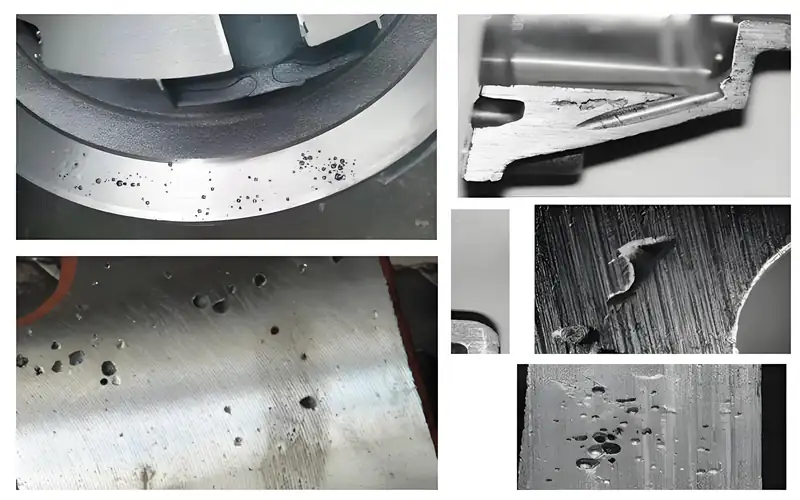5 common defects and solutions such as casting shrinkage holes, surface roughness and lack of finish
Date: 2024-08-03 Categories: Blog Views: 1779

Porosity (including air bubbles, choke holes, air pockets)
Causes of formation:
1. The preheating temperature of the mold is too low, and the liquid metal cools too quickly through the pouring system.
2, mold exhaust design is poor, gas discharge is not smooth.
3. Bad paint, poor exhaust, or even volatile or decomposing gases.
4. There are holes and pits on the surface of the mold cavity. After the liquid metal is injected, the gas rapidly expands and compresses the liquid metal, forming choke holes.
5, mold cavity surface rust, not cleaned up.
6, improper storage of raw materials (sand core), not preheated before use.
7. Poor deoxidizer, or insufficient dosage or improper operation.
The following are short methods for preventing the creation of air holes (bubbles, choke holes, air pockets).
1、Control the pouring temperature within the appropriate range to avoid excessive gas expansion.
2, mold preheating is sufficient, the use of good permeability, appropriate particle size of the coating (such as graphite), to promote the discharge of gas.
3、Adopt tilt pouring method to reduce the chance of gas retention.
4, raw materials should be properly stored in a ventilated dry place, should be preheated before use.
5, the selection of high-efficiency deoxidizer (such as magnesium), effective removal of gas in the melt.
Shrinkage and shrinkage
Causes of formation:
1, the working temperature of the mold does not reach the conditions required for directional solidification, resulting in poor gas discharge.
2, improper selection of coatings, inaccurate control of coating thickness in different parts, affecting the gas escape path.
3. The layout of the castings in the mold is not well designed, which may hinder the natural flow and discharge of gas.
4, the design of the pouring air outlet fails to give full play to its complementary shrinkage, so that part of the region in the solidification process to form a cavity.
5, pouring temperature control is not appropriate, too low will lead to increased gas solubility, too high will exacerbate the expansion and retention of gas.
Methods of prevention:
1. Increase the temperature of the grinding tool;
2、Adjust the coating thickness, uniform spraying, coating off, do not form a localized coating accumulation phenomenon;
3、Localized heating of the mold or the use of insulation materials for local insulation;
4、Hot section inlaid copper block, localized cooling;
5、Design the radiator on the mold, or accelerate the cooling rate of the local area through water, etc., or spray water outside the mold, spray water;
6, removable cooling block, rotating placed in the cavity, to avoid the cooling block itself in the continuous production process of insufficient cooling;
7. The pressurizing device is designed on the mold riser;
8. The design of the pouring system should be accurate and the appropriate pouring temperature should be selected.
The slag eye problem, which involves the entrapment of slag in the melt or metal oxides, is a common defect in the casting process
Reason: Slag eye is mainly caused by the alloy melting process and pouring process (including incorrect design of the pouring system), the mold itself will not cause slag holes, metal mold is one of the effective ways to avoid slag holes.
Methods of prevention and treatment:
1. The pouring system is set up correctly or a casting fiber screen is used.
2. Tilt pouring.
3. Strictly control the quality and choose the melt.
Cracks (hot cracks, cold cracks)
Causes of formation:
Metal mold casting is prone to crack defects because the metal mold itself has no concessions, the cooling rate is fast, which can easily lead to an increase in the internal stress of the casting, the opening is too early or too late, the pouring angle is too small or too large, the coating is too thin, which can easily lead to cracking of the casting, and the mold cavity itself is also prone to cracks.
Prevention and control methods: 1, should pay attention to the craftsmanship of the casting structure, so that the casting wall thickness of uneven parts of the uniform transition, and the use of appropriate fillet size. 2, adjust the thickness of the coating, so that all parts of the casting as far as possible to achieve the required cooling rate, to avoid excessive internal stresses. 3, pay attention to the working temperature of the metal molds, adjusting the tilt of the molds, and in time to pull out the core cracked and take out the casting slow cooling.
Cold segregation (poor fusion)
Causes of formation:
1, metal mold exhaust design is unreasonable; 2, the working temperature is too low; 3., poor coating quality (man-made, material); 4, sprue opening position is not appropriate; 5., pouring speed is too slow and so on.
Prevention and control methods: 1, the correct design of the pouring and exhaust system; 2, large thin-walled castings, the coating should not be too thin, appropriate thickening of the coating is conducive to molding; 3, appropriate increase in the working temperature of the mold; 4, the use of tilted pouring method; 5, the use of mechanical vibration of the metal mold pouring.
Sixth, the sand hole (sand hole)
Formation reason: Because the sand particles on the surface of the sand core are wrapped by copper liquid, and the casting surface to form holes.1, the sand core surface strength is poor, burnt or not fully cured.2, the sand core size is inconsistent with the outer mold, the mold is crushed when the mold is closed.3, the mold is dipped in graphite water contaminated with sand.4, the sand that is rubbed off from the sand core at the casting ladle and the casting channel is rushed into the cavity with the copper water.5, the sand that is rubbed off from the sand core at the molding ladle and the casting channel is rushed into the cavity with copper water.
Prevention and control methods: 1, sand core production in strict accordance with the process of production, check the quality; 2, the sand core and the outer mold size is consistent; 3, clean up the ink in a timely manner; 4., v. Avoid friction between the casting package and the sand core;, under the sand core when the sand blowing the sand in the mold cavity clean.
























